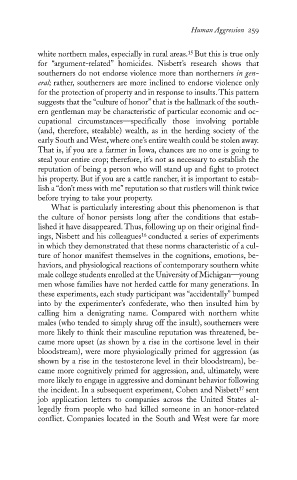Page 277 - The Social Animal
P. 277
Human Aggression 259
15
white northern males, especially in rural areas. But this is true only
for “argument-related” homicides. Nisbett’s research shows that
southerners do not endorse violence more than northerners in gen-
eral; rather, southerners are more inclined to endorse violence only
for the protection of property and in response to insults.This pattern
suggests that the “culture of honor” that is the hallmark of the south-
ern gentleman may be characteristic of particular economic and oc-
cupational circumstances—specifically those involving portable
(and, therefore, stealable) wealth, as in the herding society of the
early South and West, where one’s entire wealth could be stolen away.
That is, if you are a farmer in Iowa, chances are no one is going to
steal your entire crop; therefore, it’s not as necessary to establish the
reputation of being a person who will stand up and fight to protect
his property. But if you are a cattle rancher, it is important to estab-
lish a “don’t mess with me” reputation so that rustlers will think twice
before trying to take your property.
What is particularly interesting about this phenomenon is that
the culture of honor persists long after the conditions that estab-
lished it have disappeared. Thus, following up on their original find-
ings, Nisbett and his colleagues conducted a series of experiments
16
in which they demonstrated that these norms characteristic of a cul-
ture of honor manifest themselves in the cognitions, emotions, be-
haviors, and physiological reactions of contemporary southern white
male college students enrolled at the University of Michigan—young
men whose families have not herded cattle for many generations. In
these experiments, each study participant was “accidentally” bumped
into by the experimenter’s confederate, who then insulted him by
calling him a denigrating name. Compared with northern white
males (who tended to simply shrug off the insult), southerners were
more likely to think their masculine reputation was threatened, be-
came more upset (as shown by a rise in the cortisone level in their
bloodstream), were more physiologically primed for aggression (as
shown by a rise in the testosterone level in their bloodstream), be-
came more cognitively primed for aggression, and, ultimately, were
more likely to engage in aggressive and dominant behavior following
the incident. In a subsequent experiment, Cohen and Nisbett sent
17
job application letters to companies across the United States al-
legedly from people who had killed someone in an honor-related
conflict. Companies located in the South and West were far more

